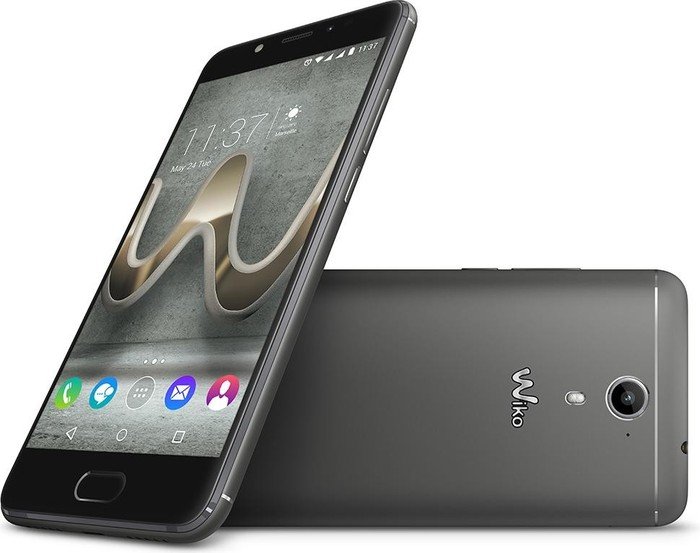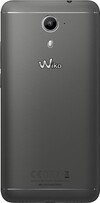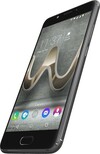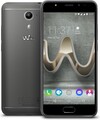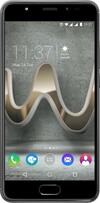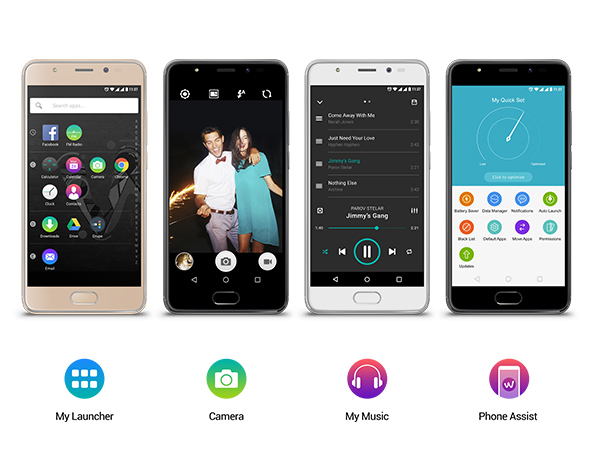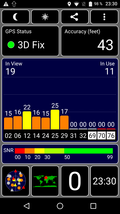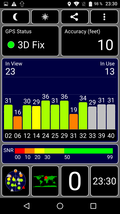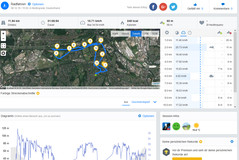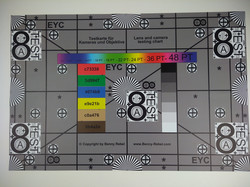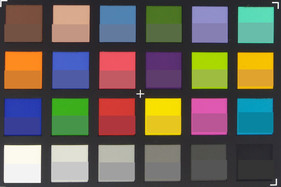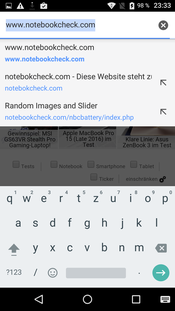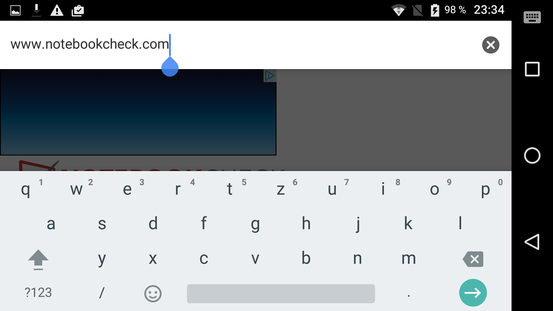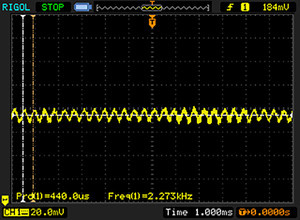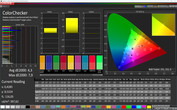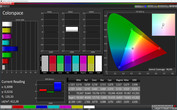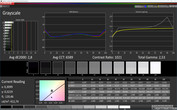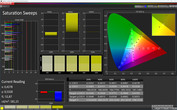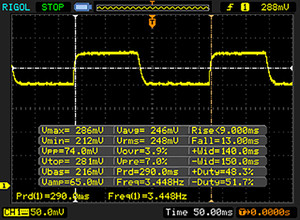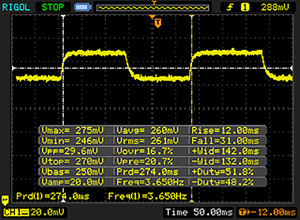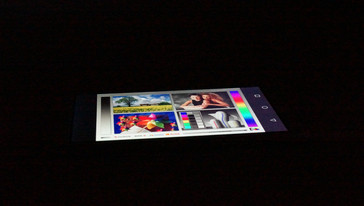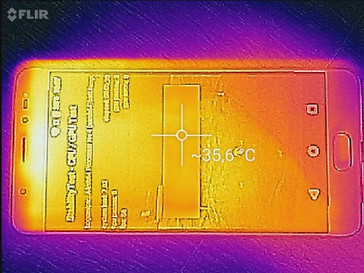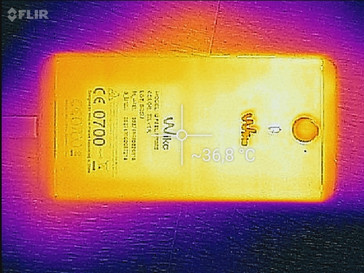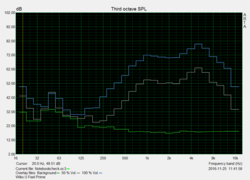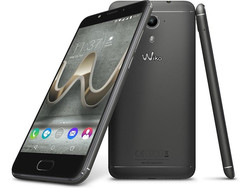Wiko U Feel Prime Smartphone Review
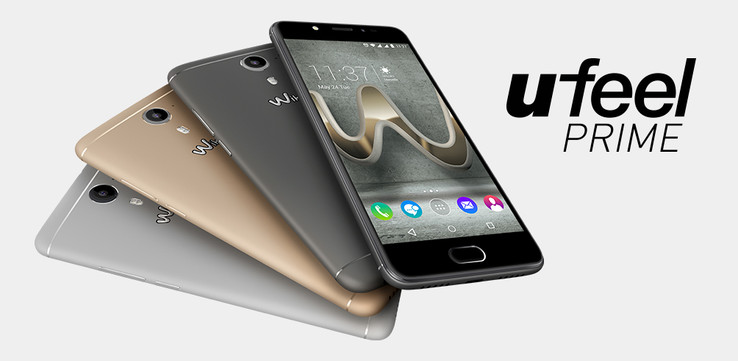
For the original German review, see here.
A few months ago, we tested Wiko's U Feel that proved to be a solid mid-range smartphone but with a camera that could not really convince us. Wiko's U Feel Prime is, so to say, the better-equipped sibling with a higher-resolution front camera, more memory, a Full HD screen, and a higher-capacity battery. It costs approximately 70 Euros (~$74) more, which is actually a good price for so many upgrades.
We compare the U Feel to find out whether investing more money is worthwhile. Furthermore, we use 5-inch handsets priced at around 300 Euros (~$316), such as the Samsung Galaxy J5, the Honor 8, the Sony Xperia XA, and the Lenovo ZUK Z2 for comparison.
Case
Unlike Wiko's U Feel, the better-equipped U Feel Prime does not offer a lime-yellow frame. Instead, colors of the season dictated by Apple prevail here: The U Feel Prime is available with a gray back and black front, silver back and white front (our review sample) or entirely in a gold tone.
The metal casing is pleasant to hold, but Wiko's logo on the back seems to have been incorporated rather carelessly and has an unpleasant feel when brushing over it. Chrome-colored highlights adorn our white model and actually make it look quite elegant. However, the outline of Wiko's U Feel Prime is not exactly slim: The smartphone has a thickness of 8.7 millimeters (~0.34).
The casing cannot be warped, and hardly produces any noise during the attempts. It also resists pressure on both the front and back. Only strong pressure on the front results in waves in the liquid crystals. The smartphone's curved shape makes it pleasant to hold, but some irregularities exist in the area of the chrome strips that the finger perceives as unpleasant.
Connectivity
A generous 4 GB of working memory and 32 GB of storage are quite a statement in the 300 Euro (~$316) price range. Two SIM cards can be used simultaneously, but the second SIM slot is also the microSD slot so that the user will have to make a decision. Hot swapping the SIM cards is possible so that the smartphone does not have to be rebooted when replacing the SIM cards.
Naturally, LTE is on-board as can be expected for 300 Euros (~$316). External storage devices can be connected via USB-OTG. NFC for near-field communication is not present.
Software
Wiko delivers its smartphone with the proprietary "My Launcher" interface. The looks and slightly modified handling distinguish it from standard Android. It is based on Android 6.0.1. At the time of testing, the security patches were from 1st September 2016 which is a few months back. It is not yet known whether an update to Android 7 will be implemented.
The apps can be listed alphabetically, and individual apps and files can be locked via a PIN code or a fingerprint. Apps for making notes, the weather or "Zenly" that allows real-time locating of family and friends are preloaded. Some duplicate apps, such as Google's news and weather app as well as Wiko's "News Republic" and its weather app coexist.
Communication and GPS
Wiko's U Feel Prime supports LTE Cat. 4 at speeds of up to 150 MBit in download and 50 MBit in upload. With four frequencies in GSM, UMTS, and LTE, there are not many options. Users traveling to exotic countries will probably not find a network. The reception quality is quite good. We usually had the full or 3/4 signal in an urban area with the well-developed Vodafone network even indoors. Downloads were performed quickly.
In terms of Wi-Fi, the user will have to be satisfied with the 802.11 b/g/n standards. Neither the less frequented 5 GHz band nor the fast 802.11ac network can be utilized. The transmission speeds in our standardized test are also relatively slow: HTC's Desire 10 Lifestyle that also at most supports 802.11n networks achieves twice the transmission speed, not to mention the fast 802.11ac Lenovo ZUK Z2 smartphone.
| Networking | |
| iperf3 transmit AX12 | |
| Lenovo ZUK Z2 | |
| HTC Desire 10 Lifestyle | |
| Wiko U Feel Prime | |
| iperf3 receive AX12 | |
| Lenovo ZUK Z2 | |
| HTC Desire 10 Lifestyle | |
| Wiko U Feel Prime | |
The smartphone managed to find our approximate location indoors. The accuracy in our test was roughly 12 meters (~39 ft). Finding the smartphone and its user with an accuracy of 3 meters (~10 ft) did not take long outdoors.
The tracking module in Wiko's U Feel Prime also did a fairly good job in the practical test. We took the review sample as well as Garmin's Edge 500 professional navigation system on a bike ride for comparison. Wiko's U Feel Prime measured a roughly 300-meter (~328 yd) shorter route, which is primarily because the smartphone often drew a straight line between two remote measuring points. The professional navigation system also had an accuracy problem in the area of the crossing this time. However, it recorded the distance across the bridge considerably more accurately than the smartphone.
Overall, Wiko's U Feel Prime is quite suitable for free-time navigation.
Telephone and Call Quality
Wiko's smartphone relies on Google's standard phone app, which is not a bad decision. The app is clearly arranged, user-friendly, and offers all the fundamental features.
The sound via the earpiece is quite good, very direct, and its volume can be set quite high. However, the microphone is quiet, and the contact could hear us with difficulty, if at all, when we spoke quietly. The sound is relatively loud via the speaker, but a noise is very audible. The microphone does not transmit quiet voices here either and it is still very subdued.
Cameras
Wiko has upgraded only the front camera and installed a higher-resolution 8-megapixel lens compared to Wiko's U Feel. Once again, a 13-megapixel lens is on the rear, but now with a dual LED flash.
We quite like the photo of the riverside at sunset taken with the U Feel Prime. The color accuracy is good, the warm sunlight and a fancy lens reflection give the photo lots of atmosphere. However, it becomes obvious that the photo is overall very blurry when looking closely. The softening effect contributes to the mood of this specific motif, but it is annoying in other scenes or when zoomed. More details are visible with higher-quality smartphone cameras, such as Samsung's Galaxy S7, but we do not like the colors as much.
The photo of the surroundings taken with the U Feel Prime also makes a relatively blurry impression. Furthermore, a visible greenish tint is seen in the photo. The smartphone also has issues with the strong contrast in the candlelight photo. The bright and dark areas have little dynamic; the Galaxy S7 has a clear advantage here.
The quality of the 1080p videos at 30 frames per second is quite decent. A visible color noise becomes evident in dark areas in the photo. However, the lens quickly adapts to changing light and adjusts the exposure accordingly. The sharpness of the recordings is also good.
Photos shot with the front camera look quite sharp, but a visible color noise is seen in darker areas. The front camera records videos at 720p. The exposure needs a much longer time to adapt to new conditions. The videos present an evident noise, especially in dark areas.
The primary camera also presents visible blurriness in the photo test under defined light conditions. The edges of fonts are clearly frayed.
The color reproduction is much too saturated and bright compared to the reference color space.
Accessories and Warranty
Wiko includes an in-ear headset for the U Feel Prime. A SIM tool for opening the tray and various adapters for different SIM sizes are also included. Of course, a charger and USB cable is present. Wiko traditionally sells quite a lot of accessories for its smartphones, but no product-specific items for our review sample are currently found on Wiko's website.
Wiko includes a 24-month warranty on its smartphones. Please see our Guarantees, Return Policies & Warranties FAQ for country-specific information.
Input Devices and Handling
Google's standard app is used as the virtual keyboard; the latest "GBoard" is preloaded. The app is clearly arranged, offers many setting options and input modes, and typing on it is smooth and fast.
The touchscreen is accurate and also responds well to inputs at the screen's edges. The fingerprint scanner below the screen functions well, wakes up the smartphone from standby, and can be used as the home button when pressed. The menu buttons are always on the screen. A special feature: Up to five different fingerprint quick commands can be assigned, for example, the index finger could automatically launch the camera while the thumb unlocks the smartphone.
Gestures can also be setup on the active or inactive screen, such as opening the phone app or the camera directly. The smartphone can be muted by turning it on its screen, double-tapping can be used for unlocking the screen or holding the smartphone to the ear automatically switches from hands-free mode to the earpiece. All these gestures and actions function quite well, especially with a bit of practice.
Display
| |||||||||||||||||||||||||
Brightness Distribution: 86 %
Center on Battery: 411 cd/m²
Contrast: 1142:1 (Black: 0.36 cd/m²)
ΔE ColorChecker Calman: 4.3 | ∀{0.5-29.43 Ø4.78}
ΔE Greyscale Calman: 2.8 | ∀{0.09-98 Ø5}
Gamma: 2.53
CCT: 6589 K
| Wiko U Feel Prime IPS, 1920x1080, 5" | Sony Xperia XA IPS, 1280x720, 5" | Lenovo ZUK Z2 IPS, 1920x1080, 5" | Honor 8 IPS, 1920x1080, 5.2" | Samsung Galaxy J5 2016 AMOLED, 1280x720, 5.2" | Wiko U Feel IPS, 1280x720, 5" | |
|---|---|---|---|---|---|---|
| Screen | -38% | -7% | -21% | -9% | -4% | |
| Brightness middle (cd/m²) | 411 | 518 26% | 512 25% | 451 10% | 289 -30% | 500 22% |
| Brightness (cd/m²) | 386 | 475 23% | 502 30% | 443 15% | 291 -25% | 485 26% |
| Brightness Distribution (%) | 86 | 81 -6% | 84 -2% | 93 8% | 96 12% | 83 -3% |
| Black Level * (cd/m²) | 0.36 | 0.61 -69% | 0.58 -61% | 0.4 -11% | 0.22 39% | |
| Contrast (:1) | 1142 | 849 -26% | 883 -23% | 1128 -1% | 2273 99% | |
| Colorchecker dE 2000 * | 4.3 | 6.8 -58% | 3.8 12% | 5.4 -26% | 4.7 -9% | 6.3 -47% |
| Colorchecker dE 2000 max. * | 7.9 | 11.4 -44% | 11.2 -42% | 9.9 -25% | 7.3 8% | 14.4 -82% |
| Greyscale dE 2000 * | 2.8 | 7 -150% | 2.7 4% | 6.7 -139% | 3 -7% | 5.2 -86% |
| Gamma | 2.53 87% | 2.35 94% | 2.09 105% | 2.33 94% | 2.03 108% | 2.17 101% |
| CCT | 6589 99% | 8151 80% | 6076 107% | 8262 79% | 6291 103% | 7536 86% |
* ... smaller is better
Screen Flickering / PWM (Pulse-Width Modulation)
| Screen flickering / PWM detected | 2273 Hz | ≤ 1 % brightness setting | |
The display backlight flickers at 2273 Hz (worst case, e.g., utilizing PWM) Flickering detected at a brightness setting of 1 % and below. There should be no flickering or PWM above this brightness setting. The frequency of 2273 Hz is quite high, so most users sensitive to PWM should not notice any flickering. In comparison: 53 % of all tested devices do not use PWM to dim the display. If PWM was detected, an average of 8108 (minimum: 5 - maximum: 343500) Hz was measured. | |||
Thanks to the good black level of 0.36 cd/m², the contrast of 1142:1 is within a good range. However, Wiko's U Feel offers a much higher contrast as well as a much higher brightness. Many manufacturers use the so-called pulse width modulation to dim their screens. The screen is simply turned off for a fraction of a second, making the screen seem darker. When the frequency is too low, sensitive users might perceive this pulse width modulation as screen flickering. Wiko's U Feel Prime also utilizes this technology at a low screen brightness, but at a high frequency so that problems should not evolve.
We notice that the colors correspond quite accurately with the sRGB reference color space in the test with the spectrophotometer and CalMAN software. Only blue tones deviate a bit too strongly. Colors are generally too saturated, but fortunately no color tint is visible to the eye even in the grayscale levels.
Display Response Times
| ↔ Response Time Black to White | ||
|---|---|---|
| 22 ms ... rise ↗ and fall ↘ combined | ↗ 9 ms rise | |
| ↘ 13 ms fall | ||
| The screen shows good response rates in our tests, but may be too slow for competitive gamers. In comparison, all tested devices range from 0.1 (minimum) to 240 (maximum) ms. » 47 % of all devices are better. This means that the measured response time is similar to the average of all tested devices (20.2 ms). | ||
| ↔ Response Time 50% Grey to 80% Grey | ||
| 43 ms ... rise ↗ and fall ↘ combined | ↗ 12 ms rise | |
| ↘ 31 ms fall | ||
| The screen shows slow response rates in our tests and will be unsatisfactory for gamers. In comparison, all tested devices range from 0.165 (minimum) to 636 (maximum) ms. » 70 % of all devices are better. This means that the measured response time is worse than the average of all tested devices (31.6 ms). | ||
The glossy screen and the somewhat low brightness do not make Wiko's U Feel as the first choice for an outdoor smartphone. At least the light sensor functions quite accurately, and usually it is possible to recognize something on the screen in the shade.
Content is also quite legible even from very flat angles. Colors hardly deviate toward the sides.
Performance
Wiko relies on Qualcomm's Snapdragon 430 in its smartphone. The SoC was launched in 2016 and has eight cores. Each quadruplet has a different maximum speed. Four cores clock at 1400 MHz during demanding tasks and four clock at 1.1 GHz when the tasks are not as demanding and save energy. The SoC supports 64-bit computing.
Compared with Wiko's U Feel, the processing performance has increased noticeably. Even Samsung's Galaxy J5 is clearly outperformed, while Sony's Xperia XA is roughly on par. Users who want a lot of power in this price range will have to take Honor's 8 or Lenovo's ZUK Z2 with much higher performance.
Wiko's U Feel Prime is sufficiently fast for navigating through the menus smoothly in routine use. Although an app sometimes needed a bit longer, all apps that we tested ran lag-free.
| AnTuTu v6 - Total Score (sort by value) | |
| Wiko U Feel Prime | |
| Sony Xperia XA | |
| Lenovo ZUK Z2 | |
| Honor 8 | |
| Samsung Galaxy J5 2016 | |
| Wiko U Feel | |
| Geekbench 4.0 | |
| 64 Bit Single-Core Score (sort by value) | |
| Wiko U Feel Prime | |
| Honor 8 | |
| 64 Bit Multi-Core Score (sort by value) | |
| Wiko U Feel Prime | |
| Honor 8 | |
| GFXBench (DX / GLBenchmark) 2.7 | |
| T-Rex Onscreen (sort by value) | |
| Wiko U Feel Prime | |
| Sony Xperia XA | |
| Lenovo ZUK Z2 | |
| Honor 8 | |
| Samsung Galaxy J5 2016 | |
| Wiko U Feel | |
| 1920x1080 T-Rex Offscreen (sort by value) | |
| Wiko U Feel Prime | |
| Sony Xperia XA | |
| Lenovo ZUK Z2 | |
| Honor 8 | |
| Samsung Galaxy J5 2016 | |
| Wiko U Feel | |
| GFXBench 3.0 | |
| on screen Manhattan Onscreen OGL (sort by value) | |
| Wiko U Feel Prime | |
| Sony Xperia XA | |
| Lenovo ZUK Z2 | |
| Honor 8 | |
| Samsung Galaxy J5 2016 | |
| Wiko U Feel | |
| 1920x1080 1080p Manhattan Offscreen (sort by value) | |
| Wiko U Feel Prime | |
| Sony Xperia XA | |
| Lenovo ZUK Z2 | |
| Honor 8 | |
| Samsung Galaxy J5 2016 | |
| Wiko U Feel | |
| GFXBench 3.1 | |
| on screen Manhattan ES 3.1 Onscreen (sort by value) | |
| Wiko U Feel Prime | |
| Sony Xperia XA | |
| Lenovo ZUK Z2 | |
| Honor 8 | |
| Samsung Galaxy J5 2016 | |
| Wiko U Feel | |
| 1920x1080 Manhattan ES 3.1 Offscreen (sort by value) | |
| Wiko U Feel Prime | |
| Sony Xperia XA | |
| Lenovo ZUK Z2 | |
| Honor 8 | |
| Samsung Galaxy J5 2016 | |
| Wiko U Feel | |
| PCMark for Android - Work performance score (sort by value) | |
| Wiko U Feel Prime | |
| Sony Xperia XA | |
| Lenovo ZUK Z2 | |
| Honor 8 | |
| Samsung Galaxy J5 2016 | |
| Wiko U Feel | |
Wiko's U Feel Prime is much faster than Wiko's U Feel when browsing on the Internet, and especially on sites with sophisticated animations in HTML 5. However, the animations stutter noticeably. We use murraytweetindex.ie as a test site, among others.
| Octane V2 - Total Score (sort by value) | |
| Wiko U Feel Prime | |
| Sony Xperia XA | |
| Lenovo ZUK Z2 | |
| Honor 8 | |
| Samsung Galaxy J5 2016 | |
| Wiko U Feel | |
| Mozilla Kraken 1.1 - Total (sort by value) | |
| Wiko U Feel Prime | |
| Sony Xperia XA | |
| Lenovo ZUK Z2 | |
| Honor 8 | |
| Samsung Galaxy J5 2016 | |
| Wiko U Feel | |
| JetStream 1.1 - Total Score (sort by value) | |
| Wiko U Feel Prime | |
| Sony Xperia XA | |
| Lenovo ZUK Z2 | |
| Honor 8 | |
| Samsung Galaxy J5 2016 | |
| Wiko U Feel | |
* ... smaller is better
We test the storage accessing speed with the AndroBench app. A surprise is uncovered in the internal storage: Accessing is very fast; Wiko's U Feel could already score with some very high access rates here. The U Feel Prime exceeds these speeds clearly and sometimes manages to place itself at the top of the comparison field.
It does not look as good when our Toshiba Exceria Pro M401 reference microSD card is accessed. Although the U Feel Prime is also much faster than Wiko's U Feel, it cannot compete with the comparison devices from Sony and Samsung.
| AndroBench 3-5 | |
| Sequential Read 256KB (sort by value) | |
| Wiko U Feel Prime | |
| Sony Xperia XA | |
| Lenovo ZUK Z2 | |
| Honor 8 | |
| Samsung Galaxy J5 2016 | |
| Wiko U Feel | |
| Sequential Write 256KB (sort by value) | |
| Wiko U Feel Prime | |
| Sony Xperia XA | |
| Lenovo ZUK Z2 | |
| Honor 8 | |
| Samsung Galaxy J5 2016 | |
| Wiko U Feel | |
| Random Read 4KB (sort by value) | |
| Wiko U Feel Prime | |
| Sony Xperia XA | |
| Lenovo ZUK Z2 | |
| Honor 8 | |
| Samsung Galaxy J5 2016 | |
| Wiko U Feel | |
| Random Write 4KB (sort by value) | |
| Wiko U Feel Prime | |
| Sony Xperia XA | |
| Lenovo ZUK Z2 | |
| Honor 8 | |
| Samsung Galaxy J5 2016 | |
| Wiko U Feel | |
| Sequential Read 256KB SDCard (sort by value) | |
| Wiko U Feel Prime | |
| Sony Xperia XA | |
| Honor 8 | |
| Samsung Galaxy J5 2016 | |
| Wiko U Feel | |
| Sequential Write 256KB SDCard (sort by value) | |
| Wiko U Feel Prime | |
| Sony Xperia XA | |
| Honor 8 | |
| Samsung Galaxy J5 2016 | |
| Wiko U Feel | |
Games
Qualcomm's Adreno 505 graphics unit is installed. It is a mid-range graphics card that also places itself exactly midfield in our comparison field in the benchmarks. The performance is high enough to still play demanding and fast-paced racing games such as "Asphalt 8: Airborne" fairly smoothly. More basic games, such as "Angry Birds" are no problem. The loading times are not unduly long, thanks to the relatively fast memory accesses.
Controls via touchscreen and position sensor function very well.
Emissions
Temperature
The maximum full load temperatures of 37.8 degrees Celsius (~100 degrees Fahrenheit) are inconspicuous. The device barely heats up during idle mode. Furthermore, the battery test of GFXBench shows us that the handset's performance remains stable even during prolonged load.
(+) The maximum temperature on the upper side is 37.8 °C / 100 F, compared to the average of 35.2 °C / 95 F, ranging from 21.9 to 247 °C for the class Smartphone.
(+) The bottom heats up to a maximum of 35.8 °C / 96 F, compared to the average of 34 °C / 93 F
(+) In idle usage, the average temperature for the upper side is 29.3 °C / 85 F, compared to the device average of 32.9 °C / 91 F.
Speaker
The speaker in Wiko's U Feel Prime is relatively loud at over 85 dB(A). The sound is surprisingly clear, and the high tones are not as unpleasantly dominant as in many other smartphone speakers. Of course, bass is hardly audible and the sound will not satisfy audiophiles. It will, however, be sufficient for an occasional YouTube video or a piece of music.
The sound via both the headset jack and Bluetooth is very clear and has presence.
Wiko U Feel Prime audio analysis
(+) | speakers can play relatively loud (85.5 dB)
Bass 100 - 315 Hz
(-) | nearly no bass - on average 30.1% lower than median
(±) | linearity of bass is average (7.4% delta to prev. frequency)
Mids 400 - 2000 Hz
(±) | reduced mids - on average 5.5% lower than median
(+) | mids are linear (6.6% delta to prev. frequency)
Highs 2 - 16 kHz
(±) | higher highs - on average 6.7% higher than median
(+) | highs are linear (6.7% delta to prev. frequency)
Overall 100 - 16.000 Hz
(±) | linearity of overall sound is average (26.1% difference to median)
Compared to same class
» 66% of all tested devices in this class were better, 6% similar, 28% worse
» The best had a delta of 11%, average was 35%, worst was 134%
Compared to all devices tested
» 80% of all tested devices were better, 4% similar, 16% worse
» The best had a delta of 4%, average was 24%, worst was 134%
Samsung Galaxy J5 2016 audio analysis
(+) | speakers can play relatively loud (84.1 dB)
Bass 100 - 315 Hz
(-) | nearly no bass - on average 32.6% lower than median
(±) | linearity of bass is average (7.1% delta to prev. frequency)
Mids 400 - 2000 Hz
(±) | higher mids - on average 7.6% higher than median
(±) | linearity of mids is average (10.9% delta to prev. frequency)
Highs 2 - 16 kHz
(±) | higher highs - on average 6.1% higher than median
(+) | highs are linear (6.5% delta to prev. frequency)
Overall 100 - 16.000 Hz
(-) | overall sound is not linear (30.2% difference to median)
Compared to same class
» 78% of all tested devices in this class were better, 4% similar, 18% worse
» The best had a delta of 11%, average was 35%, worst was 134%
Compared to all devices tested
» 88% of all tested devices were better, 3% similar, 9% worse
» The best had a delta of 4%, average was 24%, worst was 134%
HTC Desire 10 Lifestyle audio analysis
(±) | speaker loudness is average but good (75.3 dB)
Bass 100 - 315 Hz
(-) | nearly no bass - on average 20.2% lower than median
(-) | bass is not linear (18.5% delta to prev. frequency)
Mids 400 - 2000 Hz
(+) | balanced mids - only 3.3% away from median
(+) | mids are linear (4.1% delta to prev. frequency)
Highs 2 - 16 kHz
(+) | balanced highs - only 3.2% away from median
(+) | highs are linear (4.4% delta to prev. frequency)
Overall 100 - 16.000 Hz
(±) | linearity of overall sound is average (20.7% difference to median)
Compared to same class
» 36% of all tested devices in this class were better, 8% similar, 55% worse
» The best had a delta of 11%, average was 35%, worst was 134%
Compared to all devices tested
» 55% of all tested devices were better, 8% similar, 37% worse
» The best had a delta of 4%, average was 24%, worst was 134%
Frequency diagram in comparison (checkboxes above can be turned on/off!)
Energy Management
Power Consumption
The review sample is relatively efficient in terms of energy and consumes much less power than Wiko's U Feel. The consumption in the shutdown state could be somewhat lower, but overall, only Samsung's Galaxy J5 clearly undercuts Wiko's U Feel Prime in our test.
| Off / Standby | |
| Idle | |
| Load |
|
Key:
min: | |
| Wiko U Feel Prime 3000 mAh | Sony Xperia XA 2300 mAh | Lenovo ZUK Z2 3500 mAh | Honor 8 3000 mAh | Samsung Galaxy J5 2016 3100 mAh | Wiko U Feel 2500 mAh | |
|---|---|---|---|---|---|---|
| Power Consumption | -6% | -53% | -28% | 17% | -33% | |
| Idle Minimum * (Watt) | 0.66 | 0.72 -9% | 1.31 -98% | 0.78 -18% | 0.61 8% | 0.82 -24% |
| Idle Average * (Watt) | 1.66 | 1.5 10% | 2.03 -22% | 1.89 -14% | 1.41 15% | 1.61 3% |
| Idle Maximum * (Watt) | 1.76 | 1.57 11% | 2.08 -18% | 2.02 -15% | 1.51 14% | 1.8 -2% |
| Load Average * (Watt) | 2.85 | 3.48 -22% | 5.45 -91% | 5.28 -85% | 2.56 10% | 5.99 -110% |
| Load Maximum * (Watt) | 5.01 | 6.04 -21% | 6.75 -35% | 5.44 -9% | 3.1 38% | 6.7 -34% |
* ... smaller is better
Battery Runtime
The battery is much larger than in Wiko's U Feel. It can supply 11.4 Wh. Nevertheless, the difference in battery life is relatively marginal. Wiko's U Feel Prime lasts 23 minutes longer in the Wi-Fi test. A total runtime of 9:35 hours is still a good performance, but our review sample is again defeated by Samsung's Galaxy J5.
Overall, our review sample sometimes managed two days without its charger. It could last three when not used frequently. It does not support Quick Charge, and our experience shows that a full recharge takes approximately two hours using the included power supply.
| Wiko U Feel Prime 3000 mAh | Sony Xperia XA 2300 mAh | Lenovo ZUK Z2 3500 mAh | Honor 8 3000 mAh | Samsung Galaxy J5 2016 3100 mAh | Wiko U Feel 2500 mAh | |
|---|---|---|---|---|---|---|
| Battery runtime | -39% | -5% | 3% | 20% | -4% | |
| Reader / Idle (h) | 20.9 | 12.9 -38% | 24.8 19% | 26.7 28% | ||
| WiFi v1.3 (h) | 9.6 | 5.9 -39% | 9.1 -5% | 8.3 -14% | 10.7 11% | 9.2 -4% |
| H.264 (h) | 7.7 | 8.8 | 11 | |||
| Load (h) | 2.8 | 4.3 | 6.7 |
Pros
Cons
Verdict
The extra 70 Euros (~$74) compared with Wiko's U Feel are really well-invested: Wiko's U Feel Prime surpasses its "inferior-equipped sibling" clearly in almost every test. They come closest in battery life, but the screen has a higher resolution, the memory configuration is better, not to mention the performance.
Wiko's U Feel Prime also holds its own against the other competitors. However, Honor's 8 and Lenovo's ZUK Z2 offer considerably more power for a slightly higher price.
Criticism is due for the not so good screen brightness and its slightly heterogeneous illumination. The microphone is also an inferior model and transmits our voice very quietly to our contact. The cameras could also be of higher quality, and the primary camera's sharpness in particular, is not convincing.
The buyer gets a metal casing, Full HD panel, good memory configuration, and decent performance for less than 300 Euros (~$316). Wiko's U Feel Prime is very impressive and offers a good price-performance ratio.
Overall, Wiko's U Feel Prime is a recommendable smartphone from the lower mid-range that has quite a lot to offer for little money.
Wiko U Feel Prime
- 12/29/2016 v6 (old)
Florian Wimmer




